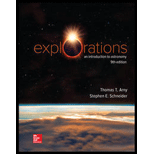
Loose Leaf For Explorations: Introduction To Astronomy
9th Edition
ISBN: 9781260432145
Author: Thomas T Arny, Stephen E Schneider Professor
Publisher: McGraw-Hill Education
expand_more
expand_more
format_list_bulleted
Textbook Question
Chapter 1, Problem 1TY
(1.1) If you are standing at Earth’s North Pole, which of the following will be directly overhead?
- (a) The celestial equator
- (b) The ecliptic
- (c) The zodiac
- (d) The north celestial pole
- (e) The Sun
Expert Solution & Answer
Want to see the full answer?
Check out a sample textbook solution
Students have asked these similar questions
Please solve and answer the question correctly please. Thank you!!
You throw a small rock straight up from the edge of a highway bridge that crosses a river. The rock passes you on its way down, 5.00 s after it was thrown. What is the speed of the rock just before it reaches the water 25.0 m below the point where the rock left your hand? Ignore air resistance.
Help me make a visualize experimental setup using a word document. For the theory below.
Chapter 1 Solutions
Loose Leaf For Explorations: Introduction To Astronomy
Ch. 1 - (1.1) What is the celestial sphere? What are the...Ch. 1 - (1.1) What is the difference between rotation and...Ch. 1 - (1.1/1.2) What is a constellation, and what is...Ch. 1 - (1.2) What causes the seasons?Ch. 1 - What causes the Moons phases?Ch. 1 - (1.3) How long does it take the Moon to go through...Ch. 1 - (1.2) Why does the position of sunrise along the...Ch. 1 - Why arent there eclipses each month?Ch. 1 - (1.1) If you were standing on Earths equator,...Ch. 1 - Prob. 2TQ
Ch. 1 - (1.1) Can you think of an astronomical reason why...Ch. 1 - Draw sketches to show the angles setting stars...Ch. 1 - Prob. 5TQCh. 1 - Prob. 6TQCh. 1 - (1.2) Why does the position of sunrise along the...Ch. 1 - (1.2) Why do we have time zones? Sketch and label...Ch. 1 - (1.3) Provide two or three pieces of evidence you...Ch. 1 - (1.3) If the Moon orbited Earth in the opposite...Ch. 1 - (1.1) If Earth turns one full rotation in...Ch. 1 - (1.2) From a latitude of 55, what is the highest...Ch. 1 - Prob. 3PCh. 1 - Prob. 4PCh. 1 - Prob. 5PCh. 1 - Prob. 6PCh. 1 - Prob. 7PCh. 1 - Prob. 8PCh. 1 - (1.1) If you are standing at Earths North Pole,...Ch. 1 - Prob. 2TYCh. 1 - Prob. 3TYCh. 1 - Prob. 4TYCh. 1 - (1.2) In which of the following locations can the...Ch. 1 - Prob. 6TYCh. 1 - (1.3) You observe the Moon rising at 6 p.m.,...Ch. 1 - (1.3) You observe the Moon rising at 3 p.m., a few...Ch. 1 - Prob. 9TYCh. 1 - (1.4) Figure 1.22 (right) shows an eclipse of the...Ch. 1 - (1.4) If the Moon were to expand to twice its...
Knowledge Booster
Learn more about
Need a deep-dive on the concept behind this application? Look no further. Learn more about this topic, physics and related others by exploring similar questions and additional content below.Similar questions
- How to solve this, given answerarrow_forwardThree point-like charges are placed at the corners of a square as shown in the figure, 28.0 cm on each side. Find the minimum amount of work required by an external force to move the charge q1 to infinity. Let q1=-2.10 μC, q2=+2.40 μС, q3=+3.60 μC.arrow_forwardA point charge of -4.00 nC is at the origin, and a second point charge of 6.00 nC is on the x axis at x= 0.820 mm . Find the magnitude and direction of the electric field at each of the following points on the x axis. x2 = 19.0 cmarrow_forward
- Four point-like charges are placed as shown in the figure, three of them are at the corners and one at the center of a square, 36.0 cm on each side. What is the electric potential at the empty corner? Let q1=q3=+26.0 µС, q2=-28.0 μC, and q4=-48.0μc Varrow_forwardPLS HELparrow_forwardPlease solve and answer the question correctly please. Thank you!!arrow_forward
arrow_back_ios
SEE MORE QUESTIONS
arrow_forward_ios
Recommended textbooks for you
 AstronomyPhysicsISBN:9781938168284Author:Andrew Fraknoi; David Morrison; Sidney C. WolffPublisher:OpenStax
AstronomyPhysicsISBN:9781938168284Author:Andrew Fraknoi; David Morrison; Sidney C. WolffPublisher:OpenStax An Introduction to Physical SciencePhysicsISBN:9781305079137Author:James Shipman, Jerry D. Wilson, Charles A. Higgins, Omar TorresPublisher:Cengage Learning
An Introduction to Physical SciencePhysicsISBN:9781305079137Author:James Shipman, Jerry D. Wilson, Charles A. Higgins, Omar TorresPublisher:Cengage Learning Stars and GalaxiesPhysicsISBN:9781305120785Author:Michael A. Seeds, Dana BackmanPublisher:Cengage Learning
Stars and GalaxiesPhysicsISBN:9781305120785Author:Michael A. Seeds, Dana BackmanPublisher:Cengage Learning Stars and Galaxies (MindTap Course List)PhysicsISBN:9781337399944Author:Michael A. SeedsPublisher:Cengage Learning
Stars and Galaxies (MindTap Course List)PhysicsISBN:9781337399944Author:Michael A. SeedsPublisher:Cengage Learning Foundations of Astronomy (MindTap Course List)PhysicsISBN:9781337399920Author:Michael A. Seeds, Dana BackmanPublisher:Cengage Learning
Foundations of Astronomy (MindTap Course List)PhysicsISBN:9781337399920Author:Michael A. Seeds, Dana BackmanPublisher:Cengage Learning

Astronomy
Physics
ISBN:9781938168284
Author:Andrew Fraknoi; David Morrison; Sidney C. Wolff
Publisher:OpenStax

An Introduction to Physical Science
Physics
ISBN:9781305079137
Author:James Shipman, Jerry D. Wilson, Charles A. Higgins, Omar Torres
Publisher:Cengage Learning

Stars and Galaxies
Physics
ISBN:9781305120785
Author:Michael A. Seeds, Dana Backman
Publisher:Cengage Learning

Stars and Galaxies (MindTap Course List)
Physics
ISBN:9781337399944
Author:Michael A. Seeds
Publisher:Cengage Learning

Foundations of Astronomy (MindTap Course List)
Physics
ISBN:9781337399920
Author:Michael A. Seeds, Dana Backman
Publisher:Cengage Learning

Time Dilation - Einstein's Theory Of Relativity Explained!; Author: Science ABC;https://www.youtube.com/watch?v=yuD34tEpRFw;License: Standard YouTube License, CC-BY